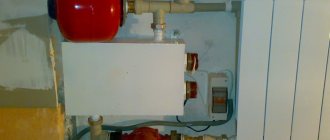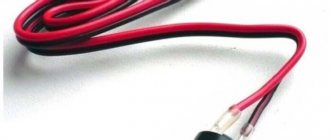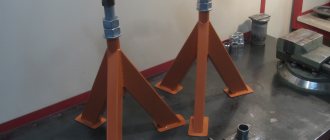Can a homemade air cooler become an alternative to modern split systems? After all, refrigeration machines that create a comfortable microclimate in the house cost a lot of money along with installation and are not affordable for everyone. Therefore, home craftsmen are trying to solve the problem cheaply and cheerfully, coming up with all sorts of cooling installations. Our goal is to consider all design options, select the most viable ones and tell you how to make a working air conditioner with your own hands for your home or car. And in order to assess the complexity of the task, we suggest first analyzing...
Operating principle of a household split system
An air conditioner is a complex household appliance that operates on the principle of transferring heat from one place to another: in the summer - from the apartment to the street, in the winter - from the environment to the house. To move heat, an interesting substance is used - freon, which can boil and turn into gas at negative temperatures.
For reference. Freon circulating in the circuits of refrigeration machines is called a refrigerant or working fluid. The key point is its evaporation and condensation, during which thermal energy is respectively absorbed and released in large quantities.
Traditional units consist of 2 blocks - external and internal.
The home split system works according to a cyclic algorithm:
- First, the refrigerant in a liquid state enters the heat exchanger of the internal air conditioner module (evaporator), which is blown by a centrifugal fan. This is where freon evaporates, causing the flow of room air to cool sharply.
- The gas then flows through a copper tube into a compressor, which raises its pressure to a certain value. The task is to force the working fluid to condense outside, where the air temperature is even higher than indoors.
- After the compressor, gaseous freon passes through the radiator of the external unit (condenser). A large axial fan forces air flow through its fins, and the refrigerant turns into a liquid phase again, releasing the room heat outside.
- At the last stage, the pressure of the liquid working fluid is reduced by passing through the expansion (throttle) valve. Now the freon is again ready to absorb heat and moves into the indoor unit, the cycle repeats again.
Diagram of the factory air conditioner
Note. During operation, a lot of condensate appears on both heat exchangers and must be discharged to the street or to the sewer. In order for the split system to switch to heating the house, freon is started in the opposite direction, and the radiators are functionally swapped.
An electronic control unit (ECU), which receives signals from various sensors, is responsible for maintaining the room air temperature and refrigerant pressure in the system. A car air conditioner operates on the same principle: the evaporator is built into the interior ventilation system, and the condenser is installed near the standard radiator of the cooling system.
Now you understand that making an evaporative air conditioner yourself at home is not as easy as it might seem. But for a car this is even more difficult to implement; here you need to be a master refrigerator. As an example, we suggest watching a video where such a specialist installed a household split system in his VAZ 2104 car:
Next, let's look at the air conditioner designs invented by craftsmen and highlight the most efficient devices that can be recommended for production.
The simplest device for home
The simplest cooling device, which does not require almost any material, financial, time, or intellectual costs, will be a design made from a fan and a wet towel. A towel is thrown over the mechanism, air passes through, evaporating the water. The evaporation process cools the towel, so the air flowing through will become slightly cooler. This method can be slightly improved by lowering the end of the towel into a container of water.
It will not be possible to cool the room this way. But for individual use it will be effective.
How to refuel a household air conditioner yourself? Action plan >>>
Simple homemade air conditioner
The principle of operation of such coolers is to blow room air through objects with a negative temperature. This capacity is usually served by ice or cold accumulators intended for special bags used for summer transportation of products.
Cold sources are placed inside a closed box, and an axial fan is built into its wall. On the other side, a hole is made to allow the cooled flow to exit. What is not used to make the case:
- an old car refrigerator with insulated walls;
- capacious plastic bottles designed for 5 liters of water or more;
- cardboard or plastic boxes with lids;
- canisters made of polymer materials.
This is what a simple cooler design looks like
Note. The air supply is provided by any small-sized fan, for example, a computer cooler.
This mini-air conditioner is also suitable for cooling the car interior; you just need to correctly connect the air blower to the on-board power supply and stock up on the required amount of ice in advance.
Advantages and disadvantages of the design
It is noteworthy that such devices actually drive cold air flow into the room. In addition, simple air conditioners are actually made from scrap materials, whose price tends to zero. The most you will have to spend on is an axial fan if you don’t have one in your household.
Installing and connecting the device in the car
Unfortunately, the disadvantages cancel out all the advantages of the cooler:
- No matter how much ice you put in the chamber, in hot weather it won’t last long, so you need to constantly freeze new water.
- While you are cooling one room, the next room is being heated by the refrigerator, where ice is being prepared. Plus, energy consumption increases.
- The duration of operation of the unit in the car depends on the supply of ice taken with you.
- The air passing through the ice is partially humidified. After some time, the room will become oversaturated with moisture, making you feel even worse than from exposure to heat.
Advice. Over-watering can be avoided if, instead of ice, you use cold accumulators that do not melt and do not turn into water. And to control and maintain optimal moisture levels, there are other household appliances.
Conclusion. The above-described air conditioners, made by yourself, can be considered operational. They can help you out in a hopeless situation, but operating the cooler is quite a troublesome task.
Types of cold accumulators
How long will the ice in the chamber last?
To answer this question, let’s calculate how much cold 1 kg of ice will release when heated from a freezing temperature of -6 °C to +20 °C. To do this, we will use the formula for calculating heat depending on heat capacity.
You need to perform 4 steps:
- We calculate the return of cold when ice melts: Q = 1 kg x 2.06 kJ/kg °C x (0 °C - 6 °C) = -12.36 kJ.
- We find the reference value of the energy released when ice melts - 335 kJ.
- We calculate how much cold the water will transfer when heated: Q = 1 kg x 4.187 kJ/kg °C x (0 °C - 20 °C) = -83.74 kJ.
- We add up the results and get -431.1 kJ or 119.75 W.
Note. The results of cold calculations in physics are also obtained with a minus sign, this is natural.
Even if you freeze ice to a temperature of minus 15 °C, you are unlikely to get more than 150 W of cold from 1 kg. This means that to intensively cool a 3 x 3 m room in heat over 30 degrees, you will have to add 1 kg of ice to your homemade air conditioner every 20-30 minutes and freeze the same amount. In practice, the consumption will be less if you are satisfied with a tolerable air temperature - 25-28 ° C.
How to assemble an air cooler
A mini air conditioner for a home or car is made as follows:
- Cut a hole in the side wall of the container equal in size to the working cross-section of the fan.
- Screw the cooler with self-tapping screws or place it on small bolts.
- Make a second hole to allow the cooled stream to exit. Another option is to attach a corrugated plastic tube to the neck of the bottle or canister. The device is ready.
Advice. From an operational point of view, it is better to use a box with a removable lid, since it is more convenient to load ice or cold accumulators into it.
All that remains is to install and connect the improvised car air conditioner. The wires from the cooler can be connected to the cigarette lighter connector, which has a powerful fuse in the circuit. The manufacturing and connection process is shown in detail in the video:
Bottled ice and floor fan
For the next method you will need an ordinary floor fan. Without modernization, there is not much sense from it. Unless, of course, you sit directly in front of him all day and night.
In fact, it simply circulates hot air around the room, but does not cool it. However, with simple manipulations, everything can be changed dramatically.
All you need to do is attach a couple of bottles of ice to it with wire. Fill plastic bottles with water and freeze them in the freezer.
When the “cooling cartridges” are ready, tie their necks together with wire.
After that, hang them behind the fan blades.
To ensure that cold air is taken in from the rear and no extraneous warm air is sucked in, glue a homemade cardboard casing around the circumference of the fan with double-sided tape.
In fact, the air conditioner is already ready for use. Most of the time when making it will take you to freeze the ice in bottles.
To have a constant replacement supply, I advise you to freeze 6-8 of them in advance. In just half an hour, such an installation can “cool down” a small room by a couple of degrees.
However, this seemingly simple method has many disadvantages.
- ice in bottles melts quickly
You will have to place a basin under the fan, and change the cartridges periodically. Therefore, you definitely can’t leave such a thing on at night.
- short circuit danger
Your floor fan is turned on via a 220V carrier. And next to the wires from it, it will be constantly humid and damp. You will also need special carriers.
Therefore, it is recommended to replace melted bottles with new ones only after turning off the power. Otherwise, the whole thing could short-circuit and lead to a fire.
Water cooling unit
The idea is simple and at the same time effective: cold water is pumped through a heat exchanger with a fan located indoors. Since its temperature lies in the range of 5-10 ° C, the air flow cools and the room becomes cooler. The source of water is a well or borehole, and the heat exchanger is a radiator from a car or an old air conditioner.
Important note. Unlike other home-made units, a water installation operates on the principle of a heater and can not only cool the air in the house, but also heat it. It all depends on the temperature of the water supplied inside the radiator.
An original idea is to insert a radiator with a fan into the case from an old TV.
The flow cooling system consists of 3 elements:
- the heat exchanger itself;
- submersible or well pump;
- insulated water supply and discharge pipelines.
Manufacturing of water conditioner
The cooler assembly procedure is as follows:
- Place and secure the car radiator in a convenient place in the room.
- Lay a supply and return line to it. To connect to the element pipes, use adapters and clamps.
- Mount the pump in a well or borehole and connect the coolant supply pipeline to the heat exchanger to it.
- Insulate the section of the supply pipe so that the water does not heat up ahead of time. It is not necessary to insulate the return line.
You can use a car heater radiator for the cooler.
To make a water conditioner and run it successfully, you need to solve 2 problems: where to put the water and how to regulate its flow rate, because the pump’s performance usually exceeds the need. We propose to solve the problem of water discharge in the following ways:
- collect in a storage container from where the garden is watered;
- transfer to another well, as a water-to-water heat pump does;
- organize a closed circulation loop with a second heat exchanger submerged at the bottom of the well.
Water circulation can be organized according to a heat pump scheme
For reference. It is not recommended to water cultivated plants with cold water. Therefore, you will kill two birds with one stone if you first heat the well water in a radiator - an air cooler.
To reduce the pump's performance, you need to control the engine speed, which is impossible without a frequency converter (aka inverter), which will cost you a pretty penny. All sorts of autotransformers and other ideas are not suitable - so you simply “put down” the electric motor of the pumping unit. Without purchasing expensive equipment, the issue can be resolved as follows:
- for a well up to 10 m deep, you can use a circulation pump for heating of the appropriate power;
- You can limit the flow of water to the radiator using a bypass valve that discharges part of it back into the well. An example of the operation of a water conditioner is shown in the next video:
Pros and cons of a flow system
Briefly about the positive aspects:
- The air conditioner is capable of both heating and cooling the room;
- the design is simple compared to a factory split system;
- even if you have to buy a pump and pipes, the manufacturing costs will be low.
We have already listed some of the negative aspects and ways to eliminate them - difficulties in regulating the supply and the problem of water discharge. There is another drawback: the system cannot be used in an apartment (there is no source of cold water) or in a car for obvious reasons.
For reference. The simplest version of a cooler can still be installed in an apartment. It is a household fan, on whose grille there is a coil made of a copper tube through which water flows. The only question is where to get such cold water and how much to pay for it according to the meter, if you take it from a water tap.
Conclusion. A homemade air conditioner - a water heater - is a completely viable design. If you wish, you can make a decent cooler for a private house, provided that there is a well on the site with groundwater of an acceptable temperature.
Cheapest option 2
Photo of the finished machine from a milk flask (can)
Finding a milk can is not a problem now. There are quite a few of them left over from Soviet times, and you can easily find a suitable option on Avito or Yulia.
A flask makes a really good distillation cube of decent size, which is suitable for distilling a large volume of mash. It is not so difficult to process it into a moonshine still, because the principle remains the same as with a saucepan.
A possible option for implementing a moonshine still from a flask.
How to convert a can into a moonshine still
I suggest reading the instructions in text format again, and then watching the video.
Hole in the cover for the fitting.
- Using a 20 mm feather drill, we make a hole in the can lid.
- We insert a brass fitting into it, which is tightly clamped from the inside with a nut and gasket.
- If you plan to monitor the temperature, you can make another hole for a bimetallic thermometer.
- We put a stainless steel gas hose on the fitting, which we connect to the steam tank.
- We make a dry steamer with our own hands from a jar; for detailed instructions, read the link provided or continue watching in a separate video.
- From the steamer we move the hose to the refrigerator, which can be made flow-through or regular. The first option is more effective and complex, but for the second you just need a large container of water (bucket).
- Let's tighten all the nuts and start making moonshine!
Making a distiller from a can on video
One of the most detailed videos from Youtube, the OverCraft channel, has collected almost 250 thousand views. The author shows all his actions on video and makes pop-up tips that describe the diameters and names of the necessary equipment.
The video is short, but it is enough to understand the general principles of processing a can into a moonshine still.
Making a steamer with your own hands
As a bonus, we are posting a video from Antonich and Alexey Podolyak, where the author makes a steamer from an ordinary can. Using this principle, you can even make a bubbler (filtration occurs through water), if it seems to you a more useful and effective device for purifying alcohol vapor.
We believe that any classic distiller should have 1 steamer or 1 bubbler. Combining them or making several at once does not make practical sense. Just wash unnecessary equipment and increase alcohol losses.
Is it possible to make an air conditioner from an old refrigerator?
An absolutely utopian idea. All materials published on the Russian-language Internet describe the same video, where a man tries to build a freezer for mushrooms from two refrigerators. Moreover, the result of this action is unknown, because the video material is incomplete. Let's imagine what it should look like:
- Both heat exchangers are carefully cut out of the refrigerator without disconnecting from the compressor, otherwise the freon will evaporate and you will have to pay for refilling.
- The compressor with condenser is taken outside the room, and the evaporator (former freezer) is installed in the room. You need to attach a fan to it for ventilation.
- The standard sensor and control unit, configured for a compressor shutdown temperature of minus 3-6 ° C, will have to be discarded and replaced with other elements, connecting the units via a relay. Otherwise, the compressor will never stop and will break down after 100-200 hours of continuous operation.
Organization of room cooling using two refrigerators built into the wall.
The results of the work are unknown. Let's discard all the technical subtleties (not the same operating mode, different brand of freon, etc.) and imagine that you managed to assemble this circuit. The maximum refrigerating power of such units is no more than 400 W or 0.4 kW. A rough calculation shows that this is enough for a room of 4 m². This is in theory, but in practice it will be even less.
Conclusion. If you belong to the noble tribe of enthusiasts and experimenters, you can try to make an air conditioner out of a refrigerator. But you will spend much more labor than you get cold weather.
A remedy for the heat of our ancestors
In times of absence of cooling systems, the use of a wet towel was considered to be a fairly effective method. They wrapped it around, for example, a bottle and placed it in a through place, where the matter cooled during the process of evaporation of water. This principle is included in many of the homemade air cooling devices presented below.
Fan + water
The main components for this system will be:
- regular fan;
- a container filled with water, a cloth (preferably a towel);
- wire for fastening;
- a suitable body for this purpose.
The operating principle of this system is based on filling the refrigerator container with ice or cold water. Under the influence of the pump, cold water enters the radiator, and the fan supplies cool air flow outside.
The use of such air conditioners allows you to significantly save your own budget not only on creating the device, but also on its installation. The proposed options are as environmentally friendly as possible and completely harmless, which is very much appreciated nowadays.
Ecology of consumption. Estate: In the summer, the issue of air conditioning becomes especially acute. When it’s hot outside, you want to have a corner where you can hide from it. It happens that there is no money or opportunity to buy a ready-made air conditioning system. Then a homemade air conditioner using improvised means will come to the rescue.
In the summer, the issue of air conditioning becomes especially acute. When it’s hot outside, you want to have a corner where you can hide from it. It happens that there is no money or opportunity to buy a ready-made air conditioning system. Then a homemade air conditioner using improvised means will come to the rescue. Such a device will fit especially well into the interior of a dacha or country house, but it can also be successfully used in an apartment. It is better to start making an air conditioner in advance, before the hot days arrive. Since it is unknown how long it will take for someone who has no experience in such matters.
Cooling using Peltier elements
The use of these parts to assemble a homemade air conditioner is a controversial issue. It's all about the energy consumption of Peltier elements (otherwise known as thermoelectric converters), which is incomparable with the amount of cold produced. Outwardly, they look like plates with 2 wires; when electricity is connected, one surface of the element generates heat, and the other - cold.
What do home craftsmen and car enthusiasts who strive for comfort do:
- Buy from 4 to 8 Peltier elements and mount them with the “hot” side on a ribbed aluminum radiator.
- This radiator is installed in such a way that it is cooled by street air.
- A cooler from the computer is attached to the “cold” side of the converters so that it supplies room air to the plate.
Air cooling circuit using a Peltier converter
Note. For better heat transfer, the element is coated with thermal paste (“hot” edge) before installation on the radiator.
Peltier elements actually cool the air flow, but at the same time they simply consume electricity. After all, half of the energy is wasted because it is converted into heat and dissipated in the atmosphere. That is, for every Watt of electricity expended you will receive no more than 0.5 W of cold, while with a split system this ratio is completely different – 1:3. You can see how this works in practice in the next video:
Copper tube+hose
Another option for air conditioning, which is quite easy to make at home from a table fan. To do this you need to prepare:
- garden rubber or plastic hose for watering;
- thin copper tube;
- table fan.
The tube is bent in a circle, leaving a gap between the sections for the unhindered passage of air flow, and secured to the device limiter with clamps. One end is connected to the tap, and the other to the drain. The cooling process is also simple - water circulates through the tube and cools it, the air flow passing through the homemade device is cooled.
The disadvantage of the system is that it can only be installed in the kitchen, which results in significant water consumption.











